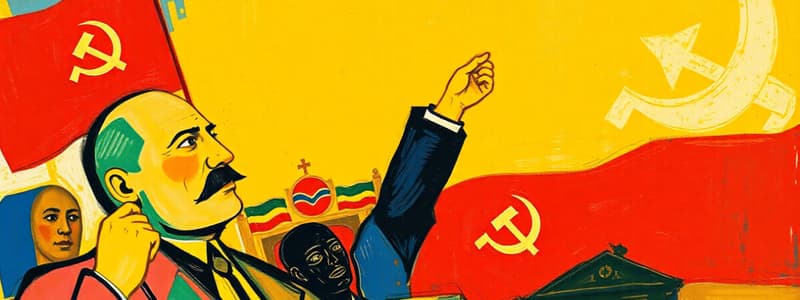Podcast
Questions and Answers
Which of the following best describes a core tenet of Bolshevik ideology?
Which of the following best describes a core tenet of Bolshevik ideology?
- The preservation of traditional social hierarchies and values.
- The gradual transition to a socialist society through democratic means.
- The establishment of a global free market to foster economic growth.
- The violent overthrow of the capitalist system by a proletarian revolution. (correct)
What was the primary objective of the Treaty of Brest-Litovsk?
What was the primary objective of the Treaty of Brest-Litovsk?
- To allow Russia to withdraw from World War I. (correct)
- To establish a free trade zone between Russia and Central Europe.
- To facilitate Russia's industrialization through German investment.
- To form a military alliance with Germany against Western powers.
The New Economic Policy (NEP), introduced by Lenin in 1921, primarily aimed to:
The New Economic Policy (NEP), introduced by Lenin in 1921, primarily aimed to:
- Completely abolish market mechanisms and establish a fully planned economy.
- Rapidly collectivize agriculture and eliminate private land ownership.
- Introduce elements of capitalism to revitalize the Soviet economy after the Civil War. (correct)
- Prioritize heavy industry at the expense of consumer goods production.
The 'October Coup' of 1917 resulted in:
The 'October Coup' of 1917 resulted in:
What was the Sovnarkom?
What was the Sovnarkom?
Which event immediately preceded the establishment of the early Soviet government (Sovnarkom)?
Which event immediately preceded the establishment of the early Soviet government (Sovnarkom)?
Following Lenin's death, the power struggle between Stalin and Trotsky primarily revolved around:
Following Lenin's death, the power struggle between Stalin and Trotsky primarily revolved around:
A key factor contributing to Stalin's rise to power in the late 1920s was:
A key factor contributing to Stalin's rise to power in the late 1920s was:
Flashcards
Bolshevik Ideology
Bolshevik Ideology
The set of beliefs guiding the Bolshevik Party, influenced by Marxism.
October Coup 1917
October Coup 1917
The armed insurrection that led to the Bolsheviks seizing power in Russia.
New Economic Policy (NEP)
New Economic Policy (NEP)
A 1921 policy that temporarily restored limited capitalism to rebuild the economy.
Stalin's Rise to Power
Stalin's Rise to Power
Signup and view all the flashcards
Totalitarianism under Stalin
Totalitarianism under Stalin
Signup and view all the flashcards
Collectivization
Collectivization
Signup and view all the flashcards
Soviet Foreign Policy (1917-1941)
Soviet Foreign Policy (1917-1941)
Signup and view all the flashcards
Gulags
Gulags
Signup and view all the flashcards
Study Notes
Russia and the Soviet Union (1917-1941)
- Key Features:
- Bolshevik ideology's theory and practice
- Different views within the Bolshevik party and the USSR
- Bolsheviks consolidating power
- Political and economic transformation
- Social and cultural transformation
- Nature and impact of Stalinism
- Aims, nature, and effectiveness of Soviet foreign policy
Bolshevik Consolidation of Power
- Overview: Bolshevik ideology, October 1917 coup, and early Soviet government.
- Treaty of Brest-Litovsk: Outcome of the treaty and relation to the Russian Civil War.
- Civil War: Context and significance.
- New Economic Policy (NEP): Introduction and implementation.
Power Struggle After Lenin's Death
- Impact of Bolshevik consolidation: Establishing the USSR.
- Power struggle in the 1920s: Key figures like Stalin, Trotsky, and others.
- Reasons for Stalin's rise: Factors contributing to his leadership.
The Soviet State Under Stalin
- Nature of the USSR: Dictatorship and totalitarianism in the USSR under Stalin.
- Economic Transformation: Collectivization and Five-Year Plans, their impact on society.
- Political Transformation: Growth of the Party, use of terror, show trials, and Gulags. Propaganda and censorship.
- Social and Cultural Change: Societal changes during Stalin's rule.
- Soviet Foreign Policy (1917-1941): Nature of Soviet foreign policy, the role of ideology.
Studying That Suits You
Use AI to generate personalized quizzes and flashcards to suit your learning preferences.




